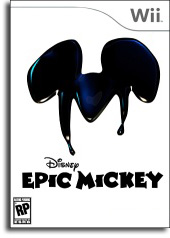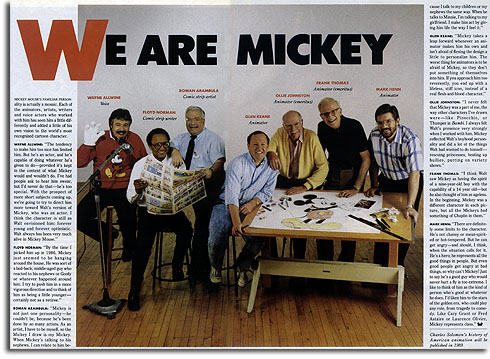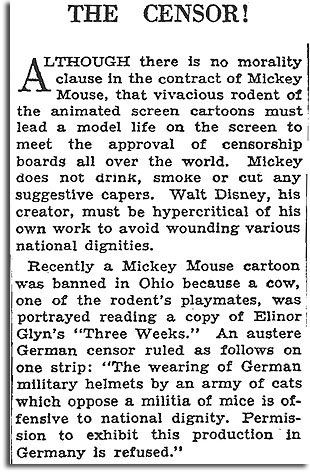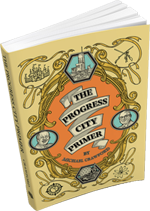 “Wouldn’t you rather have your child watching cartoons than… than reading Elinor Glyn?” “What Elinor Glyn reads is her mother’s business!”
“Wouldn’t you rather have your child watching cartoons than… than reading Elinor Glyn?” “What Elinor Glyn reads is her mother’s business!”One thing that many Disney fans have long groused about, and something that I’ve talked about here, is the process by which Mickey Mouse has been transformed over the years from a funny and entertaining character to a bland corporate icon. Many people forget that those early black and white Mickey shorts were hilarious; Mickey came off as a cross between Chaplin and Douglas Fairbanks, finding himself in a number of out-sized adventures based on the popular fiction of the day.
But the issue of Mickey’s slide into mediocrity isn’t something we can blame on Michael Eisner or the latter-day corporatization of the company. It isn’t even something we can hang on the meek stewardship of Card Walker. No, this is a rare problem that goes all the way back to Walt’s rule – way, way back as a matter of fact.
It seems that the issue of what Mickey would or wouldn’t, or should or shouldn’t, do goes all the way back to his infancy. In 1930, just two years after his theatrical debut and at the height of his popularity, a number of theaters and localities were already up in arms about the scandalous antics of the world’s favorite cartoon character. Perhaps it’s no surprise; after all, busybodies and self-appointed crusaders for virtue have plagued popular entertainment since time immemorial. But rarely have the efforts of the thought police centered so heavily on the wardrobe of animated mice or the reading habits of cows.
This censorship proved more than a minor irritant to Disney, though. “Objectionable” scenes couldn’t be merely snipped out of the films, they had to be replaced with new scenes so as to not disturb the timing of the soundtrack. I wonder if these scenes, mentioned in the following interview with Mr. Mouse from November of 1930, still exist?
 The subject of Mickey’s relevance as an entertainer has been a hot topic lately; this seems to happen at least once a decade. It happened in the 1980s after Michael Eisner’s arrival at Disney, and it happened in the 1990s with the release of Runaway Brain. We’ve also seen attempts at revivals with the Mickey Mouse Works and House of Mouse television anthologies. This time, the discussion accompanies the hype leading up to 2010’s release of Epic Mickey for the Wii gaming console. Designer Warren Spector had been reluctant to tackle a Mickey-related title, as the character has become so devoid of… character. Like many of the previous attempted revivals, Spector has looked to Mickey’s early work for inspiration. The early peeks have been intriguing, with many characters from Mickey’s early years and adventures in print popping up. Oswald the Lucky Rabbit and the Phantom Blot? Yes, please.
The subject of Mickey’s relevance as an entertainer has been a hot topic lately; this seems to happen at least once a decade. It happened in the 1980s after Michael Eisner’s arrival at Disney, and it happened in the 1990s with the release of Runaway Brain. We’ve also seen attempts at revivals with the Mickey Mouse Works and House of Mouse television anthologies. This time, the discussion accompanies the hype leading up to 2010’s release of Epic Mickey for the Wii gaming console. Designer Warren Spector had been reluctant to tackle a Mickey-related title, as the character has become so devoid of… character. Like many of the previous attempted revivals, Spector has looked to Mickey’s early work for inspiration. The early peeks have been intriguing, with many characters from Mickey’s early years and adventures in print popping up. Oswald the Lucky Rabbit and the Phantom Blot? Yes, please.
Hopefully, there won’t be any Elinor Glyn.
 The men behind Mickey in 1988 and their thoughts about the character. From left to right: Wayne Allwine, Floyd Norman, Roman Arambula, Glen Keane, Ollie Johnston, Frank Thomas and Mark Henn.
The men behind Mickey in 1988 and their thoughts about the character. From left to right: Wayne Allwine, Floyd Norman, Roman Arambula, Glen Keane, Ollie Johnston, Frank Thomas and Mark Henn.









Recent Comments